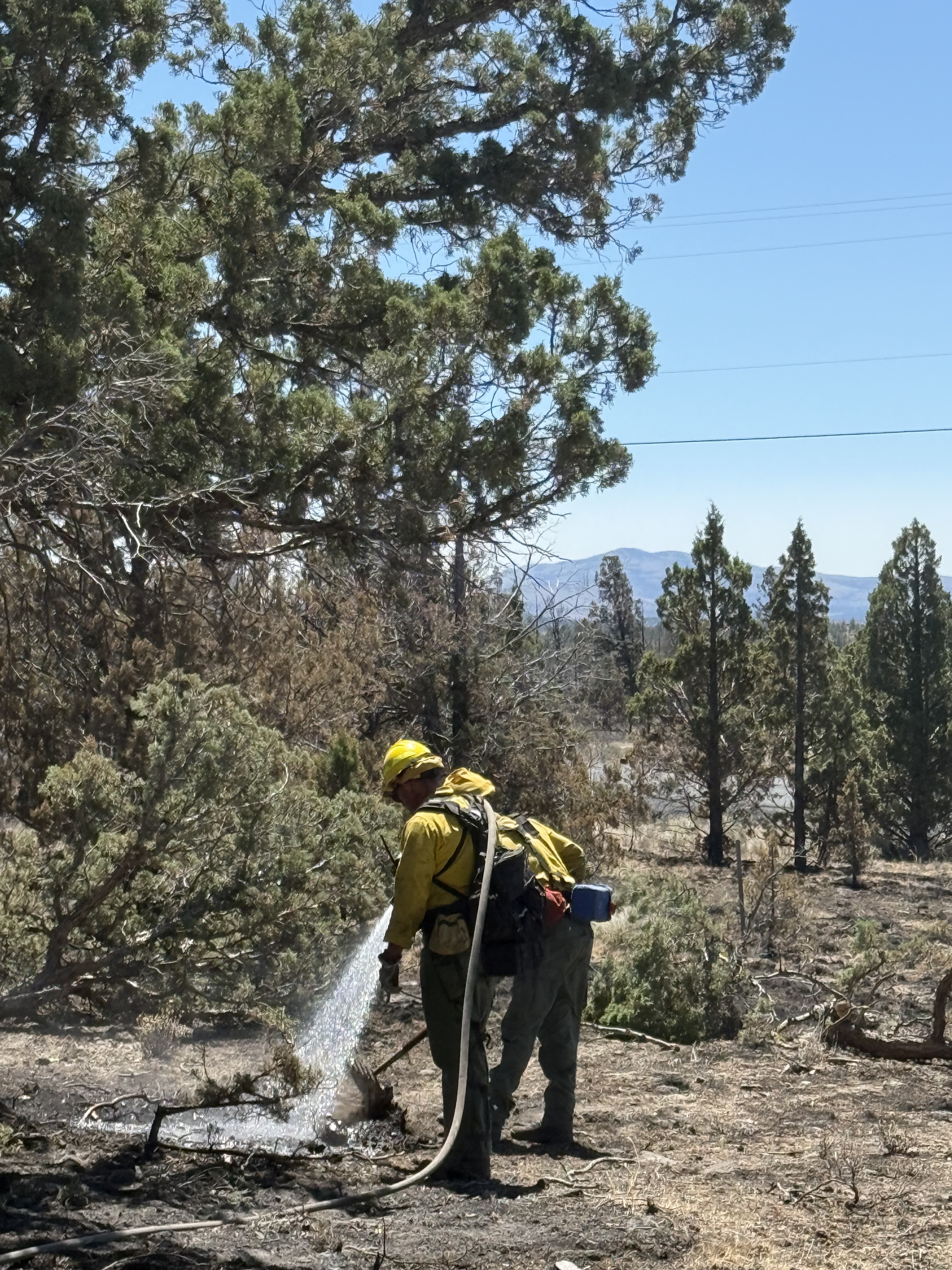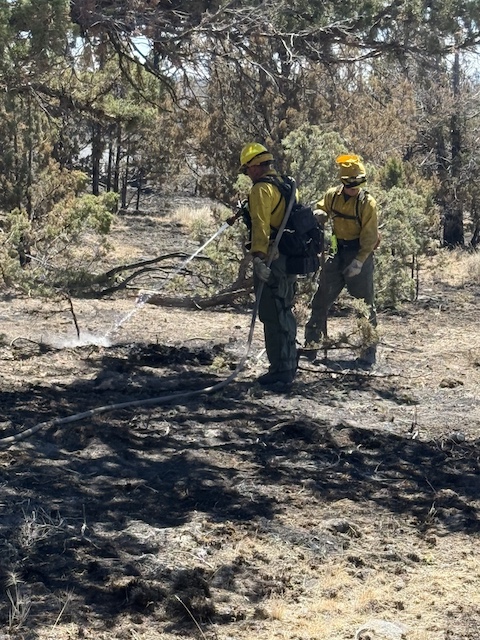Built to survive wildfire: Sisters-area home leads Oregon’s push for fire resilience
Published 5:45 am Wednesday, July 16, 2025

- Christina Maier has taken measures to keep her Sisters home safe from wildfires including Hardie Plank siding, triple pane windows and concrete patios. 04/28/25 (Dean Guernsey/The Bulletin)
Certified by insurance-backed safety group, the Tollgate home could be a model for lowering risk — and restoring coverage
As state leaders seek the right recipe for wildfire resilience, one homeowner near Sisters is leading the charge.
Christina Maier’s home in the wooded Tollgate neighborhood, a short walk from the Deschutes National Forest, is the first in the state to receive a certification from an insurance safety group that shows her home is less likely to burn down when faced with flying embers and pulsing heat.
State officials are hopeful that tying resilience to science-based standards will not only help communities withstand burns, but lead to relief from a crisis of rising insurance costs and dropped coverage in rural areas.
Trending
Along with new funding, Maier is helping to set the stage for a new level of wildfire preparedness.
“The path has been cleared. The laws are in place, the funding is in place. Is it enough? That’s still left to be seen,” Oregon Fire Marshal Mariana Ruiz-Temple said in an interview.
Meanwhile, wildfires are ramping up across the state, and have already destroyed dozens of homes in Oregon this summer.
New standards
In May, the state of Oregon announced a partnership with the Insurance Institute for Business & Home Safety, a research group funded by insurance companies that’s developed science behind preventing destruction to buildings from all types of natural disasters, including wildfires.
Maier had already received the group’s Wildfire Prepared Home certification last fall. She and her husband, David, bought land in Tollgate in 2021 and built a home there. She quickly became involved in the community’s wildfire preparedness efforts, and now leads them as the chair of the Firewise committee.
“The more I know, the more concerned I am,” Maier said.
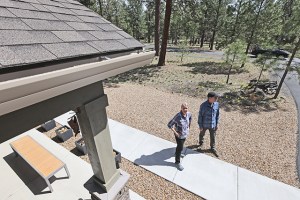
Christina and David Maier have done a considerable amount of work to establish defendable space on their Sisters property including gutter screens and a substantial fire break around the entire house. (Dean Guernsey/The Bulletin)
Trending
Maier lives just northwest of Sisters in the Tollgate neighborhood, an old Brooks-Scanlon logging cut that was sold and subdivided into 440 residential lots in the 1970s. As homes were built, new growth of ponderosa pines filled the spaces between them.
A logging road separates the 346-acre development from the Deschutes National Forest. Before the logging operation and housing development, wildfire burned through this area on a regular basis, as it did across much of Deschutes County.
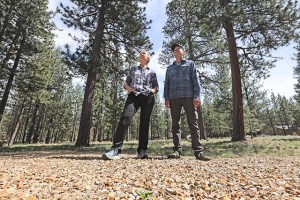
Christina and David Maier have done a considerable amount of work to establish defendable space on their property in sisters including trimming up tree branches and installing rock around the home to create a fire break.. (Dean Guernsey/The Bulletin)
But the idea is that Maier’s house would act as a fortress against oncoming flames.
Her house is guarded by a moat of crushed rock landscaping 30 feet wide in some places. Her front porch is made of concrete. Her vents are made of steel mesh with holes small enough that tiny burning embers cannot float through. Her windows have three panes so radiant heat won’t blast them to pieces.
Last month, state officials and wildfire researchers with the insurance group met for a public demonstration in Salem. Firefighters torched bark mulch in front of two side-by-side structures — one hardened to the wildfire standard and the other without. Only the latter went up in flames.
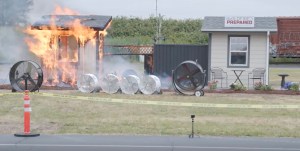
An image from a video of a demonstration last month in Salem shows a structure without defensible space or home hardening measures while the ‘wildfire prepared home’ survives after both were introduced to flames. (Insurance Institute form Home & Business Safety)
Wildfire researchers have honed the home hardening standards at the research group’s testing facility in South Carolina, which can simulate wildfires, hurricanes and other disasters.
After launching the program in 2022 in California, the certified homes haven’t faced full-fledged fire in the wild, but some have survived exposure to embers. That state has a building code for wildfire prone areas that resembles parts of the insurance group’s wildfire certification. The insurance group’s certification laid the groundwork for the city of Sisters as it adopted a defensible space code for new development.
“We know that the building codes work, and we know the science behind them works as well,” said Steve Hawks, senior director for wildfire with the insurance group and former California wildfire official.
Waiting for science to prove itself
For Maier, getting the certification was an experiment of her own.
She reached out to her State Farm insurance agent to see if the program would lead to a discount.
The agent said no. But that doesn’t mean it never will.
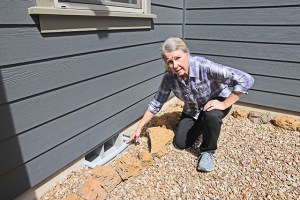
Christina Maier has taken measures to keep her Sisters home safe from wildfires including 1/8 inch mesh screen foundation vents and keeping five inches of space between the siding and the ground. (Dean Guernsey/The Bulletin)
As wildfires become increasingly destructive and insurance companies incur higher costs from natural disasters of all types, some homeowners in wildfire-prone areas across the west and in Central Oregon are experiencing a crisis with rising insurance rates and dropped policies. Average home insurance premiums in Oregon have doubled since 2018, from $583 to $1,035 in 2024, according to data provided by the Department of Consumer and Business Services. Rates at which companies are refusing to renew home insurance policies have also doubled.
Janet Huerta, who has lived in Tollgate for nearly 30 years and also helps lead wildfire efforts, said Farmers Insurance recently discontinued her policy, along with others in the neighborhood.
Officials are hopeful a solution will crystallize from the state’s partnership with the insurance safety group.
“I don’t know if it will lead to immediate relief, but it’s definitely going to stabilize our ability to have insurance coverage in our state for our homeowners, which is really, really important,” Gov. Tina Kotek said during a video call with Oregon journalists with Carpenter Media Group last week.
First, communities need to prove they can live with wildfire, said Kenton Brine, president of the insurance industry group NW Insurance Council. According to Brine, Oregon requires insurers to inform homeowners about whether they recognize wildfire mitigation efforts, but does not require them to provide discounts or write policies. Insurers need the confidence that even the largest wildfire might only burn 40 homes — not 4,000, he said. Oregon will need a period of time without major home losses for insurers to be drawn back in, Brine said.
State Farm spokesperson Tom Hartmann said the company believes the wildfire prepared home program has “great potential” to reduce risk. He said the company supports “actuarially sound” rating — in other words, the certification could eventually be linked to discounts or renewed policies, but only after certified homes survive real-world wildfires with less damage.
A long way to go
This year marked a shift in the state’s wildfire strategy as the Legislature walked back a controversial wildfire hazard map that tied building codes and buffers to high-risk properties across the state. Lawmakers passed new funding for wildfire preparedness and directed state agencies to study ways to ease the insurance crisis.
Deschutes County is already among the most prepared for wildfire in the state when it comes to community organizing. Nearly 80 communities have the Firewise recognition, meaning they participate in education and events like vegetation clearing in common areas and wildfire preparedness assessments.
But even within those communities, there is still a long way to go. Maier estimates that out of the 440 homes in Tollgate, about one-third have at least started the process of preparing their property for wildfire.
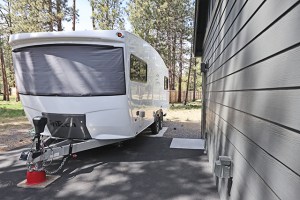
Christina and David Maier park their trailer away from their house to secure defendable space on their property in sisters. (Dean Guernsey/The Bulletin)
That process is more complicated for most people than it was for Maier, who built her home with wildfire in mind three years ago. The insurance group charges $125 to receive the certification. Research from 2024 showed retrofitting a home for wildfire on a basic level usually costs between $2,000 and $15,000, but can cost up to $100,000 in some cases.
Huerta, the Firewise leader whose home was built in the 1990s, has chipped away at fortifications over the years, replacing vents, wooden decks, removing a carport and creating a plant-free buffer around the home. But she can’t yet afford the cost of replacing her home’s siding with fire-resistant material.
Some assistance from the state could be on the way for people like Huerta. The Oregon Legislature this year passed HB 3940, which will raise millions in wildfire funding through a tax on oral nicotine products. That includes grants from the Oregon State Fire Marshall’s office for wildfire preparedness funding, including grants for home hardening.
With more work, entire neighborhoods can become certified as “wildfire prepared” through the insurance safety group.
Neighborhood-scale preparedness is key to protecting major losses, said Ray Miao, a rural fire board member and president of the Woodside Ranch Homeowners association in southeast Bend.
“If you do it right, community-wide, it benefits the entire community. What good is it if you have defensible space and home hardening on your house, but your neighbor doesn’t do a thing?” Miao said.
“Sooner or later, something’s going to ignite,” he added.




